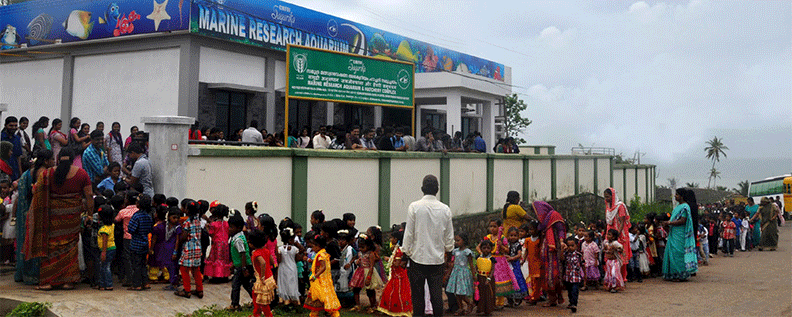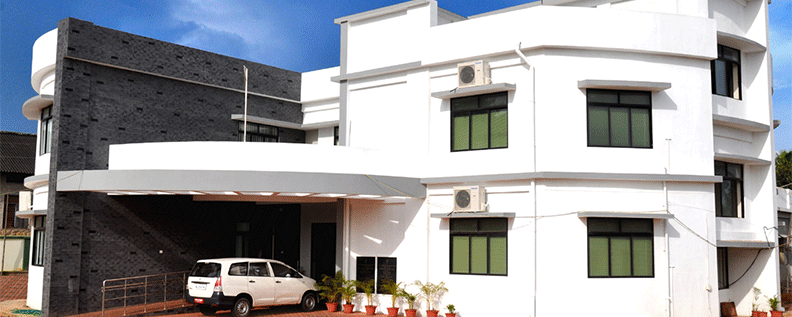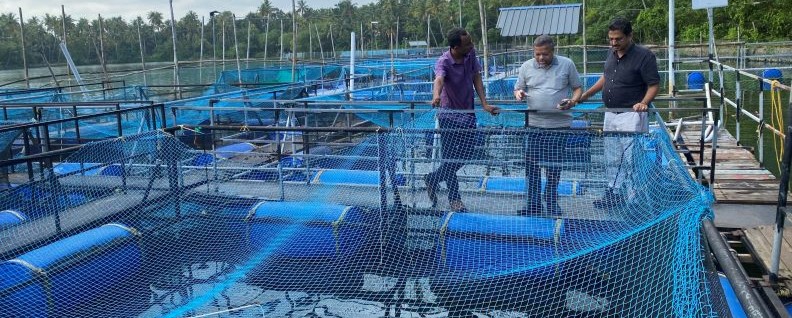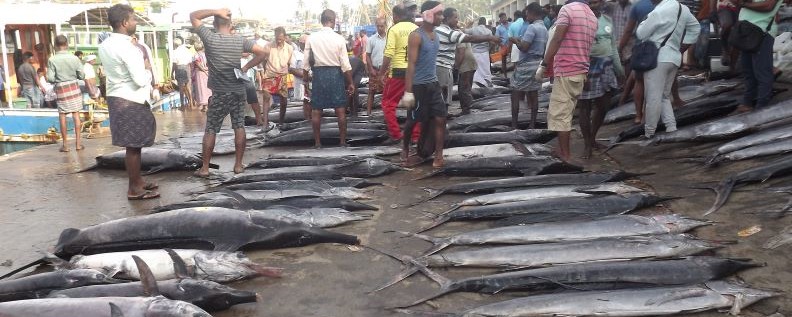- Thrust Areas of Research
-
Major Achievements
- National Brood Bank of silver pompano for continuous seed production and supply
- Seed production technology of food fishes like silver pompano, pink ear emperor fish, spangled emperor fish and banded grunter.
- Seed production of marine ornamental fishes like clown fishes, damsel fishes including new reports of cloudy damsel, Marcias anthias, sea goldie, azure damsel, black bar chromis, Maldives damsel, wide banded shrimp goby and lemon damsel.
- Hatchery production technologies of green mussel, brown mussel, edible oyster, pearl oyster and short neck clam.
- Developed stock and mass culture protocols for 14 species of marine copepods suitable as live feed for fish larval rearing.
- Database on marine fishery resources including the status of exploitation, taxonomy, biology and ecology of all major resources.
- Monitoring and assessment of the small-scale fisheries along the southern coast of Kerala.
- Popularized farming technologies of marine food fishes (cage and pen culture), ornamental fishes, mussels, oysters, lobsters and IMTA.
- Training and extension activities especially cage culture, ornamental fish culture, bivalve seed production, farming, and live feed culture.
-
Technology or Concepts Developed
- Seed production technologies of food fishes like silver pompano, pink ear emperor fish, spangled emperor fish and banded grunter, marine ornamental fishes like clown fishes, damsel fishes including the new reports like cloudy damsel, Marcia's anthias, sea goldie, azure damsel, black bar chromis, Maldives damsel, shrimp goby and lemon damsel.
- Hatchery production technologies for bivalves like green mussels, brown mussels, edible oysters, pearl oysters and short neck clams.
- ICAR-certified technologies like seed production of black bar chromis and clutchless spat of Crassostrea madrasensis
- Developed culture technology of marine copepods for use as live feeds for fish larval rearing.
- Assessed the pattern and succession of fouling communities in net cages of coastal waters in Kollam.
- Developed a concept centred on utilizing fish otoliths for jewellery making, empowered the fisherwomen of Vizhinjam and started the commercial production of jewellery using otoliths.
- Captive propagation of host sea anemones; bubble tip sea anemones and long tentacle anemones through asexual reproduction.
-
Ongoing Research Projects
- Resource assessment and management framework for sustainable marine fisheries of Kerala.
- Development of strategies to sustain the stock and fishery of large pelagics in Indian waters.
- Developing management plans for sustainable exploitation and conservation of elasmobranchs in India.
- Marine eggs and larval studies along the Indian Coast.
- Investigations on the Scyphozoan and Cubozoan jellyfish diversity and distribution along the Indian Coast.
- Assessment and management of small-scale bivalve and gastropod fisheries for sustainable exploitation in India
- Science for sustainability: developing an integrated assessment framework to support management decisions for marine fisheries in Kerala & Lakshadweep
- Captive breeding and seed production of important fin fishes, shellfishes and other invertebrates for sustainable mariculture, fisheries enhancement, and conservation
- Development of sustainable mariculture practices through technological innovations in cage and coastal farming
- Development of sustainable mariculture practices through technological innovations in cage and coastal farming.
- Development of hatchery technologies for commercially important species in mariculture
- Critical assessment of reproductive strategies and growth patterns of selected high-value finfishes for mariculture
- All India Network Project on Mariculture (ICAR)
- Scheduled Cast Sub Plan Project (ICAR)
- National Innovations in Climate Resilient Agriculture (ICAR)
- E. G. Silas Centre of Excellence and Innovations in Marine Fish Microbiome and Nutrigenomics (DBT)
- Establishment of Marine Ornamental Fish Hatchery in Lakshadweep (NCDC)
- Standardization of mass production and evaluation of resting egg production in tropical marine copepods for the use as live feed for fish larval rearing. (DBT)
- Breeding and supply centre for damsel fishes (BIRAC)
- Development of pilot scale open sea eco-mussel farms in India-A blue growth project (PMMSY)
- Computer vision-based monitoring of fishes in marine cage farming (ICAR)
- Bivalve seed supply for mangrove conservation and livelihood generation (Government of Maharashtra)
Institute Projects
Funded Projects
Consultancy Project
-
Scientific Staff
No Name Designation 1 Dr. B. Santhosh Principal Scientist & Head, Vizhinjam RC 2 Dr. M. K. Anil Principal Scientist 3 Dr. Krishna Sukumaran Senior Scientist 4 Dr. Anuraj A. Scientist 5 Dr. Rathi Bhuvaneswari G. Scientist 6 Dr . Surya S. Scientist 7 Smt. P. Gomathi Scientist 8 Shri. Ambarish P. Gop Scientist
Explore CMFRI
- About Us
- What We Do
- Our Locations
- Knowledge Centres
- Others












